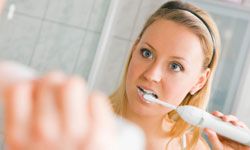We all know -- or should know -- that good oral hygiene habits include both brushing and flossing at least twice a day to keep cavities at bay. But you may not realize that the benefits of these good habits go beyond preventing tooth decay. Good oral hygiene also helps to keep teeth white, and reduces the risk of gum disease and cardiovascular disease. But even the most dedicated brushers and flossers may find weaknesses in their routine: their tools and their technique. Before we talk tools, though, let's learn a few basics about our teeth.
Our teeth are made up of four parts: the root (periodontal ligament and the cementum), which holds the tooth in the jaw, the pulp, which is the nerve inside each tooth, the dentin, which is the hard layer that surrounds and protects the pulp, and the enamel, which is the outermost layer of the tooth. The enamel is the part of the tooth that we brush, polish and whiten. And it's the enamel that bears the impact of daily wear and tear, taking damage from common things such as the foods we eat (especially acidic, sugary and starchy foods), acid reflux, tooth grinding, nail biting, medications and dry mouth.
Advertisement
This wear and tear on tooth enamel, a problem known as tooth abrasion, can cause enamel to become soft and begin to erode. Symptoms of weakened enamel include tooth sensitivity, usually to cold or sweet, teeth with a yellow hue, which can happen when dentin becomes exposed, teeth with cracks or chips and indentations on the tooth surface.
What you might not have considered, though, is that your toothbrush -- the tool with which you're trying to keep your teeth clean and healthy -- may be contributing to wear and tear on your tooth enamel. Let's go deeper into how tooth brushing and your choice of toothbrush can put you at risk for weakened enamel.
Advertisement

